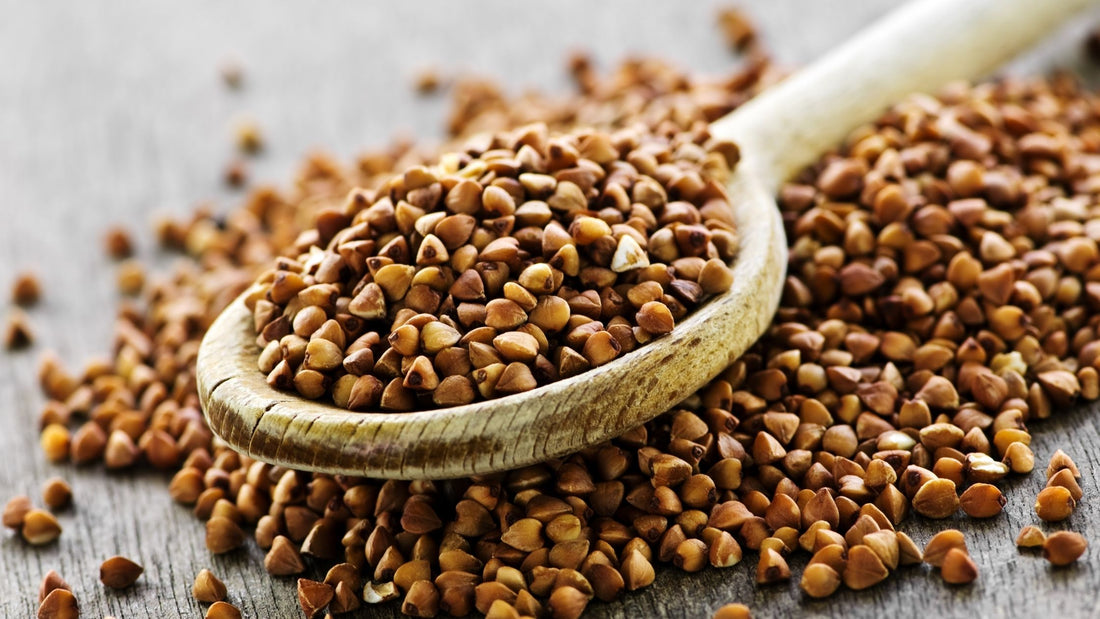
Buckwheat - What, why & how
Naturally YoursShare

If you are hunting for foods that avoid Gluten but still can deliver all the health benefits of whole grains, you are in a luck!!
Yes, I mean Buckwheat here.
Buckwheat not only serves as a wonderful substitute to whole grains, but also provides a rich, slightly nutty flavour that makes it a tasty and a healthy addition to a variety of recipes.
The seeds of Buckwheat are themselves called as groats and they have become popular among the gluten free crowd.
HEALTH BENEFITS OF BUCKWHEAT

Buckwheat has an excellent nutrient profile
1. Improves Digestion-
Being a good source of fibre and niacin, buckwheat is a good choice for digestive health.
Fibre supports the intestines in digesting food efficiently ad helps move food through the digestive tract, thus encouraging weight loss too.
2. Helps support heart health
Buck wheat, being a whole grain contains fibre and other nutrients that are important for heart health.
According to Phytotherapy Research / Volume 23, Issue 7/ p- 993-998, there is a strong link between diets that were higher in whole grain foods and a lower risk of heart disease.
Similar studies prove that buckwheat may lower blood pressure, which can also improve heart health.
3. Managing Blood sugar levels and Diabetes too
Buckwheat, being a whole grain, is a source of complex carbohydrate. Complex carbohydrate can help people manage their blood glucose levels.
Usually, the body takes longer to break down complex carbohydrates than simple carbohydrates. This process slows down digestion further, thus keeping blood sugar levels stable for longer hours.
According to Exp Diabetes Res. 2012; 2012: 375673, Published online 2012 Apr 4, buckwheat has a positive effect on insulin and blood glucose in mice with Diabetes on a high- glucose diet.
4. Weight management-
Satiety is the feeling of fullness after a meal. This feeling is very important in preventing weight gain or promoting weight loss.
Foods which increase Satiety can offset hunger for more extended periods and thereby reduce the total calorie intake for the day.
Buckwheat being high in protein, helps in weight management because of higher satiety values with fewer calories than any other types of food.

5. A great food option for Celiac disease
While the name “Buckwheat” can make people with gluten intolerance/ celiac disease shy away, this food is not actually a wheat! Rather it’s a seed.
This option makes buckwheat a wonderful alternative for people with glucose intolerance or anyone else committed to eating a gluten free diet.
7. Protects against Cancer
The anti-oxidants and phenolic compounds mentioned below help to fight against certain types of cancer.
8. Source of Vegetable Protein
Buckwheat is an excellent source of Digestible plant protein. This protein content is not quite high as certain beans and legumes, but it is higher than most of whole grains.
9. Reduces risk of Gallstones
The insoluble fibre in buckwheat greatly decreases the chances of developing Gallstones.
10. Improves Bone health
11. Prevents Anaemia
12. Boosts mood
13. Improves skin and hair health
NUTRITION PROFILE OF BUCKWHEAT
100gms of Buckwheat contains
Calories- 343 kcal
Water- 10%
Protein- 13.3gms
Carbohydrates- 71.5gms
Sugar- 0gms
Fibre- 10gms
Fat- 3.4gms
Buckwheat contains a variety of anti-oxidants in order to fight oxidative stress or even reduce risk of developing Cancer. These anti-oxidants include Rutin, Quercetin, Vitexin, D-chiro-inositol.
Buckwheat is also an excellent source of minerals like Copper, Magnesium, Manganese and Phosphorus.
HEALTHY WAYS TO EAT BUCKWHEAT-
Similar in size to wheat kernels, Buckwheat has a triangular shape and a hull that should be removed before consuming. You can purchase Buckwheat groats in health stores or even choose between brands online.
To harness the power of this pseudo cereal for yourself, cook the whole groats at a ratio of 1:2 with water, and then simmer for 30 minutes. You can also consume raw buckwheat groats after soaking and draining the raw groats to make them easier to digest.
Below mentioned is a scoop of creative plus fun ways to add it into your meals!
Buckwheat porridge is a healthful alternative to the other breakfast cereals.
You can also make Pancakes with buckwheat flour and you can dress this up with few fresh berries and nuts!

Salads- Boil Buckwheat groats in salty water, strain and then add to fresh salads!
Multigrain flour- You can make a multigrain flour by mixing buckwheat and other flours. This helps add fibre to your chapatis or even for people with gluten intolerance or those on a gluten free diet.
Buckwheat muffins- A good gluten free option. Combine buckwheat with bananas, cinnamon and eggs to create a healthy version.
It can also be used in Granola.
Pudding- Mix Buckwheat groats with Greek yogurt, chia feeds, fruits and nuts to make a tasty breakfast pudding.
Noodles- Buckwheat flour can be used to create soba noodles.
Soups
Buckwheat tea is a tonic that is nutritious

THE HEALTHY TAKE- A- WAY
The above sections look at the evidence for possible health benefits of adding buckwheat to the diet.
Trending Articles
1) What to eat when - Read Now
2) Healthy ways to satisfy your sweet tooth - Read Now
3) Morning habits to help you lose weight - Read Now
ABOUT THE AUTHOR

Sneha Jain, Dietician
Sneha is a Post graduate with specialization in Nutrition and Dietetics. She is a university topper and holds 5+ years of experience in Apollo hospitals, VLCC, slimsutra and first cry fit-kids .
She has successfully counselled clients all over India for weight loss, weight gain, diabetes, hypertension, PCOD, hypothyroid, Pregnancy and lactation and growth charts for children. She has her own diet consultation e-clinic (diet_diariez)
She believes in customized diets and eating local and seasonal foods. Her counselling not only involves diet planning, but also lifestyle modification and stress relief strategies.


